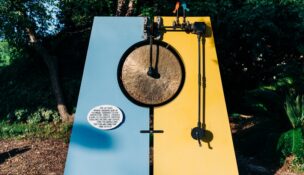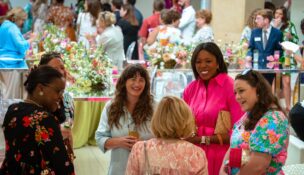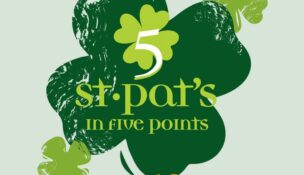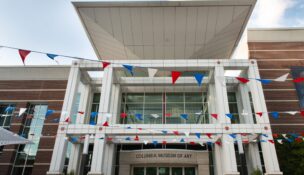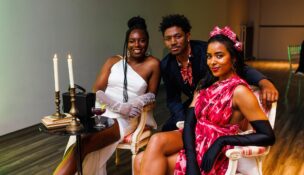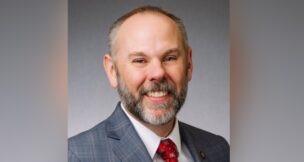Exclusive exhibition showcases art of the Catawba Nation from the last 50 years
CRBR Biz Wire //May 30, 2023//
Exclusive exhibition showcases art of the Catawba Nation from the last 50 years
CRBR Biz Wire //May 30, 2023//

Columbia, S.C. – The Columbia Museum of Art announces featured summer exhibition Resurgence and Renaissance: Art of the Catawba Nation Since 1973, on view Saturday, June 10, through Sunday, September 3, 2023, only at the CMA. Organized by the CMA and shown in partnership with the University of South Carolina Lancaster, Resurgence and Renaissance is a 50-year anniversary exhibition that builds off a 1973 CMA exhibition of Catawba potters recognized as pillars of excellence in their craft. Since then, the citizens of the Catawba Nation continue to preserve and advance their heritage through artistic traditions and innovation. Opening day festivities include a performance from Catawba drum group Women of the River.
“On behalf of the CMA, we are honored to present the stories, history, and culture of the Catawba people through their artistry, while also forging new friendships with the Nation and its citizens, alongside USC’s Native American Studies Center in Lancaster, SC,” says Jackie Adams, CMA director of art and learning. “I hope visitors will not only learn something new about the Catawba people, but also appreciate their significant artistic contributions historically, today, and into many tomorrows.”
Featuring a range of arts and artists of the Catawba Nation from 1973 to present, Resurgence and Renaissance centers around Catawba pottery, the oldest continuous earthenware tradition in North America, dating back thousands and thousands of years. Basketry, beadwork, quilts, digital art, and photography round out the exhibition to showcase the living traditions of Catawba arts, culture, and heritage.
“Our late archivist, Brent Burgin, once observed that when the Egyptians were building the pyramids, Catawbas were making pottery,” says Dr. Stephen Criswell, director of Native American studies and professor of English and folklore at USC Lancaster. “Catawba pottery is recognized by scholars and collectors as a tradition which often features, paradoxically, strict adherence to tradition and vibrant creativity and innovation. It is an art form that reflects history and heritage, but at the same time offers the best of potters a vehicle for expressing their own individual talents and creativity.”
Resurgence and Renaissance offers roughly 70 works of art from more than 30 of the finest Catawba makers over the last half century, including those practicing today. Featured artists include: Sara Ayers, Brooke Bauer, JoAnn Bauer, DeAnn Beck, Betty Blue, Doris Blue, Mildred Blue, Monty Branham, Edith Harris Brown, Keith Brown, Louise Bryson, Catherine Sanders Canty, Eric Canty, Nola Harris Campbell, Beckee Garris, Evelyn George, Mandy George, Susan George, Faye Greiner, Beula Harris, Bill Harris, Georgia Henrietta Harris, Reola Harris, Billie Anne McKellar, Alex Osborn, Earl Robbins, Margaret Robbins, Arzada Brown Sanders, Caroleen Sanders, Cheryl Harris Sanders, Fred Sanders, Freddie Sanders, Verdie Sanders, and Florence Wade.
Indigenous to the Carolinas, the Catawba Nation is the only federally recognized tribe in the state of South Carolina. Their modern-day tribal lands are located in York County, South Carolina, though their ancestral lands extend through the Piedmont region of North and South Carolina and into southern Virginia. The heart of the Nation is the Catawba River, where Catawbas and their ancestors have lived and collected clay for pottery for millennia. The Catawba pottery tradition is only taught to Catawba citizens and remains a guarded and protected art form.
The 1973 CMA exhibition Catawba Indian Trade Pottery of the Historic Period aimed to create a catalyst for understanding the pottery tradition’s cultural value within the state and to highlight four prominent potters of the time — Sara Ayers, Doris Blue, Georgia Henrietta Harris, and Arzada Brown Sanders — whose work represented the tradition. Curated by scholar Steve Baker, this seminal exhibition expanded interest in Catawba pottery among collectors and scholars, changed the economic values placed on the pottery by makers and collectors, and helped inspire a new period of creativity among the potters.
Resurgence and Renaissance: Art of the Catawba Nation Since 1973 is curated by Brittany Taylor-Driggers, associate professor of art and art history and director of campus collections and galleries at USC Lancaster, and Jackie Adams, CMA director of art and learning. Works on view are primarily on loan from the USC Lancaster Native American Studies Center, with the rest sourced from private loans and the CMA Collection.
“For years the NASC faculty and staff discussed the importance of Baker’s 1973 exhibition and the artistic period that followed,” says Taylor-Driggers. “It has been a privilege to work on this exhibition with the CMA and with Catawba artists Brooke Bauer, Beckee Garris, Sharon Norton, and Alex Osborn.”
Resurgence and Renaissance Program Highlights:
Opening Celebration for Resurgence and Renaissance: Art of the Catawba Nation Since 1973
Saturday, June 10 | 12:00 – 4:00 p.m.
Celebrate the opening of featured exhibition Resurgence and Renaissance: Art of the Catawba Nation Since 1973 with a family-friendly afternoon at your museum. Be on Boyd Plaza at 12:30 p.m. to enjoy Catawba women’s drum group Women of the River performing traditional songs and dances. At 2:00 p.m. take in a conversation between Brittany Taylor-Driggers, director of campus collections and galleries and associate professor of art and art history at USC Lancaster, and Jackie Adams, CMA director of art and learning. Plus be on the lookout for docents with an “Ask me about the art!” button throughout the galleries for an opportunity to chat and ask questions. CMA members are invited to bring a friend along between 1:00 and 4:00 p.m. to enjoy food by Mohawk chef Dave Smoke McCluskey, who promotes the use of Indigenous, organic, sustainable, and locally/regionally grown ingredients, as well as foraged foods and medicines. Free with membership or admission.
Stroller Tour: Featured Exhibitions
Saturday, June 17 | 10:30 – 11:30 a.m.
Take a tour of featured exhibitions Resurgence and Renaissance: Art of the Catawba Nation Since 1973 and Tina Williams Brewer: Stories of Grace with infants in tow! Bring your little ones along for the ride on a stroller-friendly tour for caregivers with babies up to age two. Fussy, crying, or wiggly babies welcome! Baby wearing is encouraged. Free with membership or admission. Registration required as space is limited.
In Conversation: Catawba Law and Indigenous Sovereignty
Thursday, July 20 | 6:30 p.m. – 7:30 p.m.
Join us during extended Thursday hours for a conversation on Indigenous sovereignty with Jeff Harris, Catawba citizen and tribal governance attorney for the Catawba Nation, and Marcia A. Zug, the Miles and Ann Loadholt Professor of Family Law at the University of South Carolina. With a complicated history with state and federal courts in the U.S., tribal nations and their attorneys must navigate complex legal ecosystems to protect the rights of their citizens both locally and federally. Harris discusses his experiences as legal representation for the Catawba Nation, where he works in constitutional reform, governing ordinances, and improving the tribal court of laws, while Zug shares her perspective as a professor of Federal Indian Law at USC. The pair discusses some of these significant issues as well as their collaborative work at the USC School of Law leading students to help develop a full code of laws for the Catawba Nation. Free with membership or admission.
Jeff Harris is a citizen of the Catawba Nation as well as its tribal attorney. In this capacity, he leads the in-house legal department of the Nation and directs the establishment and development of a tribal public safety department, tribal courts, and related justice services. In addition, he serves on the Tribal In-House Counsel Board of Directors and Iswa Head Start Policy Committee and volunteers as a youth mentor at the Catawba Nation Boys & Girls Club. Harris graduated from Duke University School of Law in 2011.
Professor Zug teaches family law, advanced family law, and American Indian law at the University of South Carolina School of Law. She has published numerous articles on family law, immigration law and policy, and American Indian law. Much of her research focuses on the history of marriage as well as the intersection of family law and Indian law. Her book Buying a Bride: An Engaging History of Mail-Order Matches was reviewed in The New Yorker, The Atlantic, and The Times Literary Supplement. Her latest book, You’ll Do: A History of Marrying for Reasons other than Love, was published by Steerforth Press in January 2023. Zug’s law review articles have appeared in publications such as The Yale Law Journal, The American Indian Law Review, and The Family Law Quarterly. She has also advised national organizations such as The Women’s Refugee Commission, The National Indian Child Welfare Association, and The Southern Poverty Law Center on the legal issues facing Native American and immigrant families.
This program is funded in part by SC Humanities, a state program of the National Endowment for the Humanities.
Indigenous Corps of Discovery Tour with DeLesslin George-Warren
Sunday, July 23 | 2:00 – 3:00 p.m.
Join DeLesslin “Roo” George-Warren, Catawba Nation citizen, for a special tour through Resurgence and Renaissance: Art of the Catawba Nation Since 1973 and the CMA Collection. The tour is part of his longest ongoing project, the Indigenous Corps of Discovery Tours, which presents unsettling tours of collections and museums, bringing to the forefront stories of indigenous peoples, colonization, and survivance. The project began in 2016 at the Smithsonian’s Presidential Portrait Gallery and has since taken place at the Utah Museum of Fine Art and the Nordic Museum in Seattle, Washington. Free with membership or admission. Registration required as space is limited.
DeLesslin “Roo” George-Warren is a queer artist, speaker, and organizer from Catawba Indian Nation whose work ranges from performance to installation art, community education, food sovereignty, and language revitalization. Since 2017 he has worked for his tribal community on various projects including the Catawba Language Project, Catawba Food Sovereignty Project, developing learning continuums for Catawba education and justice programs, and public school teacher trainings. In 2018 George-Warren was recognized as a “40 Under 40 in Indian Country” by the National Council on American Indian Enterprise Development. He was selected as a 2017 Dreamstarter by Running Strong for American Indian Youth, and in 2016 he was recognized as a “25 Under 25” by United National Indian Tribal Youth. George-Warren has performed, lectured, and exhibited throughout the U.S. including at the Utah Museum of Fine Arts, College of Charleston, Vanderbilt University, and Ithaca College.
This program is funded in part by SC Humanities, a state program of the National Endowment for the Humanities.
Becoming Catawba: A Conversation with Dr. Brooke Bauer
Sunday, July 30 | 2:00 – 4:00 p.m. | Conversation at 2:00 p.m. | Book signing at 3:00 p.m.
As part of the 50-year anniversary exhibition Resurgence and Renaissance: Art of the Catawba Nation Since 1973, join CMA Director of Art and Learning Jackie Adams in conversation with Catawba citizen, historian, writer, and artist Dr. Brooke Bauer to discuss her new book Becoming Catawba: Catawba Indian Women and Nation-Building, 1540-1840. The book explores how Catawba women were and are central figures in the history of the Catawba people, examining their vital roles as women, mothers, providers, and protectors that created, promoted, and preserved Catawba identity and helped build a nation. Free with membership or admission. Books available for purchase and signing.
This program is funded in part by SC Humanities, a state program of the National Endowment for the Humanities.
________________
Resurgence and Renaissance: Art of the Catawba Nation Since 1973 is organized and shown in partnership with the University of South Carolina at Lancaster. Supporting Sponsors: Dr. Suzan D. Boyd and Mr. M. Edward Sellers. Friend Sponsors: Barbara B. Boyd; Ann Marie Stieritz and John B. Carran. Patron Sponsor: South Arts. Media Sponsors: Grace Outdoor; WXRY 99.3 FM. Grantors: City of Columbia; Experience Columbia SC; Richland County Government; South Carolina Arts Commission; Discover South Carolina; a grant from the Coastal Community Foundation at the request of CMA member Bonnie Adams Kapp.
i





